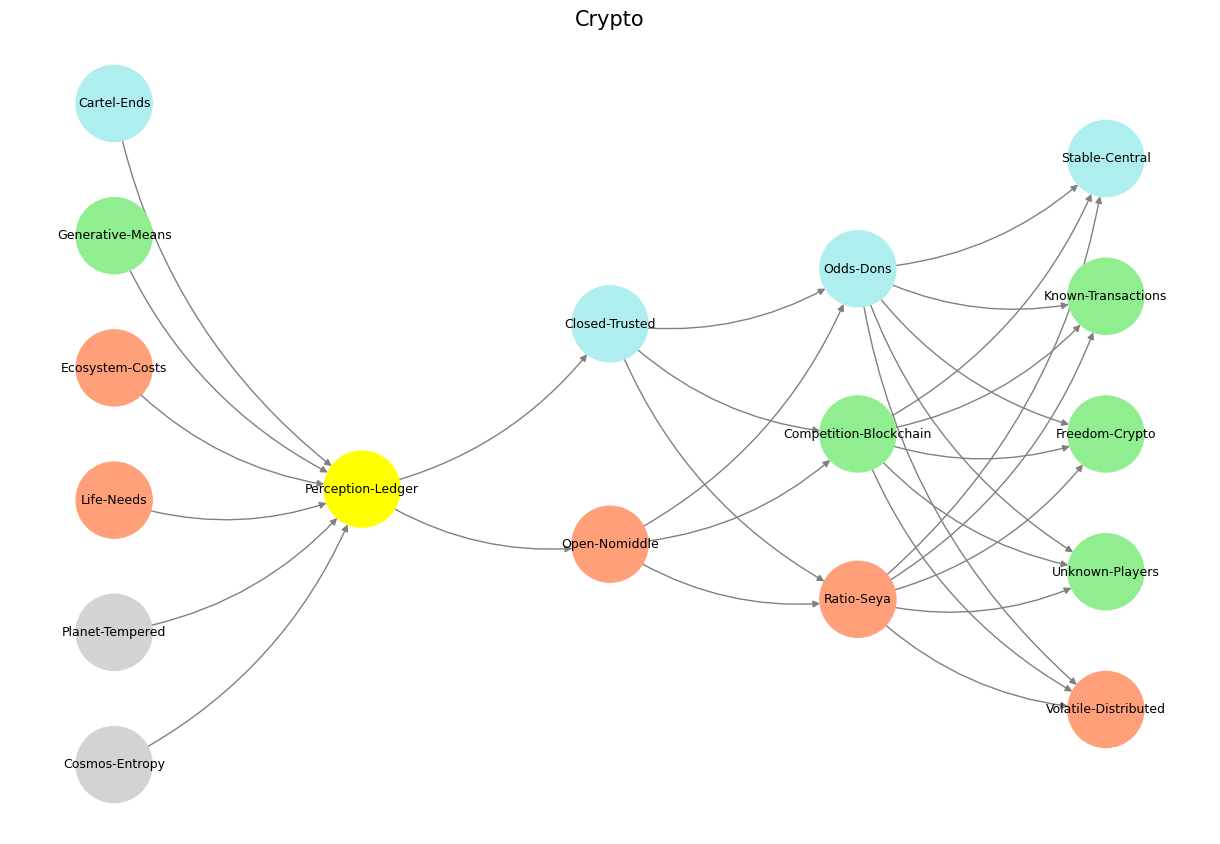Risk#
The provided neural network framework represents an intricate layering of concepts that intertwines the abstract and the practical. The structure is built with a deep sensitivity to both the hierarchical and lateral relationships within systems, drawing inspiration from fields as diverse as cosmology, economics, and computational agency. Each layer of this neural network is deliberately titled to evoke a thematic resonance, aligning with broader philosophical and operational paradigms.
The “World” layer serves as the foundational tier, encapsulating the universal forces that govern existence. It begins with “Cosmos-Entropy,” representing the universal principle of disorder, and progresses through “Planet-Tempered” and “Life-Needs,” signifying the gradual structuring of order from chaos. “Ecosystem-Costs” highlights the transactional and often exploitative dynamics within natural systems, while “Generative-Means” and “Cartel-Ends” reveal the tension between constructive creation and monopolistic control. This layer metaphorically mirrors the physical universe’s transition from randomness to structured complexity, underscoring the interplay between generativity and entropy.

Fig. 14 Trump—Flanked By Larry Ellison, Sam Altman, & Masayoshi Son—Announces Project Stargate. President Trump, flanked by top tech executives and AI experts, announces a major new AI initiative called Project Stargate. Our App provides infrastructure that connects this to the academic medicines workflows#
The “Perception” layer narrows the focus to human cognition and awareness, epitomized by the “Perception-Ledger.” This node acts as the mediator between external inputs and internal interpretations, serving as the network’s reflective core. It is an abstract ledger where sensory inputs are categorized, weighted, and reconciled, symbolizing the human need to make sense of a complex world.
The “Agency” layer ventures into the dynamics of interaction and control. It includes “Open-Nomiddle” and “Closed-Trusted,” representing contrasting modes of agency. The former suggests decentralized, boundary-less systems, while the latter indicates systems reliant on trust and authority. This duality reflects the ongoing negotiation between freedom and order, a theme intrinsic to both human psychology and modern blockchain systems.
There are questions about open models rather than closed models, is the government putting its finger on a scale for one versus another? It’s a little confusing
– Ethan Mollick
The “Generative” layer expands on the ideas of creation and competition. Nodes like “Ratio-Seya,” “Competition-Blockchain,” and “Odds-Dons” reflect a nuanced understanding of generative processes in competitive environments. These concepts merge the philosophical underpinnings of growth and the practical mechanisms of distributed systems, such as blockchain, which thrive on generative and adversarial equilibria.
Finally, the “Physical” layer grounds the network in tangible realities. It juxtaposes “Volatile-Distributed” and “Stable-Central,” embodying the tension between decentralized volatility and centralized stability. Nodes like “Freedom-Crypto” and “Known-Transactions” reflect the dualities of innovation and accountability. The physical layer is a testament to the challenges of implementing abstract ideals in real-world systems, where human and technological constraints dictate outcomes.

Fig. 15 The numbers in private equity don’t add up because its very much like a betting in a horse race. Too many entrants and exits for anyone to have a reliable dataset with which to estimate odds for any horse-jokey vs. the others for quinella, trifecta, superfecta#
The network’s visualization strategy enriches its theoretical framework with clarity and coherence. Node colors are carefully assigned to emphasize their symbolic roles: yellow for perception, paleturquoise for structured systems, lightgreen for generative growth, and lightsalmon for the sacrifices inherent in maintaining ecosystems. The positions of the nodes reflect their relative roles within the hierarchy, with y-positions illustrating relationships within a layer and x-offsets denoting progression between layers.
Edges within the graph link nodes across layers, ensuring continuity and interdependence. The visualization employs curved connections to symbolize non-linear, multi-directional influences, emphasizing the network’s dynamic and adaptive nature. The entire structure exudes a sense of balanced tension, reflecting the broader theme of reconciliation between competing forces—freedom and control, entropy and order, individuality and collectivity.
In its entirety, this neural network serves as a conceptual fractal, capturing the essence of systemic interactions within a multi-layered framework. It is not merely a technical artifact but a philosophical reflection on the interplay of forces that shape our world, offering a lens to explore the complexities of generative systems, cognitive agency, and physical constraints. The elegant design and layered symbolism invite both technical exploration and profound contemplation.
Show code cell source
import numpy as np
import matplotlib.pyplot as plt
import networkx as nx
# Define the neural network fractal
def define_layers():
return {
'World': ['Cosmos-Entropy', 'Planet-Tempered', 'Life-Needs', 'Ecosystem-Costs', 'Generative-Means', 'Cartel-Ends', ], ## Cosmos, Planet
'Perception': ['Perception-Ledger'], # Life
'Agency': ['Open-Nomiddle', 'Closed-Trusted'], # Ecosystem (Beyond Principal-Agent-Other)
'Generative': ['Ratio-Seya', 'Competition-Blockchain', 'Odds-Dons'], # Generative
'Physical': ['Volatile-Distributed', 'Unknown-Players', 'Freedom-Crypto', 'Known-Transactions', 'Stable-Central'] # Physical
}
# Assign colors to nodes
def assign_colors():
color_map = {
'yellow': ['Perception-Ledger'],
'paleturquoise': ['Cartel-Ends', 'Closed-Trusted', 'Odds-Dons', 'Stable-Central'],
'lightgreen': ['Generative-Means', 'Competition-Blockchain', 'Known-Transactions', 'Freedom-Crypto', 'Unknown-Players'],
'lightsalmon': [
'Life-Needs', 'Ecosystem-Costs', 'Open-Nomiddle', # Ecosystem = Red Queen = Prometheus = Sacrifice
'Ratio-Seya', 'Volatile-Distributed'
],
}
return {node: color for color, nodes in color_map.items() for node in nodes}
# Calculate positions for nodes
def calculate_positions(layer, x_offset):
y_positions = np.linspace(-len(layer) / 2, len(layer) / 2, len(layer))
return [(x_offset, y) for y in y_positions]
# Create and visualize the neural network graph
def visualize_nn():
layers = define_layers()
colors = assign_colors()
G = nx.DiGraph()
pos = {}
node_colors = []
# Add nodes and assign positions
for i, (layer_name, nodes) in enumerate(layers.items()):
positions = calculate_positions(nodes, x_offset=i * 2)
for node, position in zip(nodes, positions):
G.add_node(node, layer=layer_name)
pos[node] = position
node_colors.append(colors.get(node, 'lightgray')) # Default color fallback
# Add edges (automated for consecutive layers)
layer_names = list(layers.keys())
for i in range(len(layer_names) - 1):
source_layer, target_layer = layer_names[i], layer_names[i + 1]
for source in layers[source_layer]:
for target in layers[target_layer]:
G.add_edge(source, target)
# Draw the graph
plt.figure(figsize=(12, 8))
nx.draw(
G, pos, with_labels=True, node_color=node_colors, edge_color='gray',
node_size=3000, font_size=9, connectionstyle="arc3,rad=0.2"
)
plt.title("Crypto", fontsize=15)
plt.show()
# Run the visualization
visualize_nn()


Fig. 16 Change of Guards. In Grand Illusion, Renoir was dealing the final blow to the Ancién Régime. And in Rules of the Game, he was hinting at another change of guards, from agentic mankind to one in a mutualistic bind with machines (unsupervised pianos & supervised airplanes). How priscient!#

